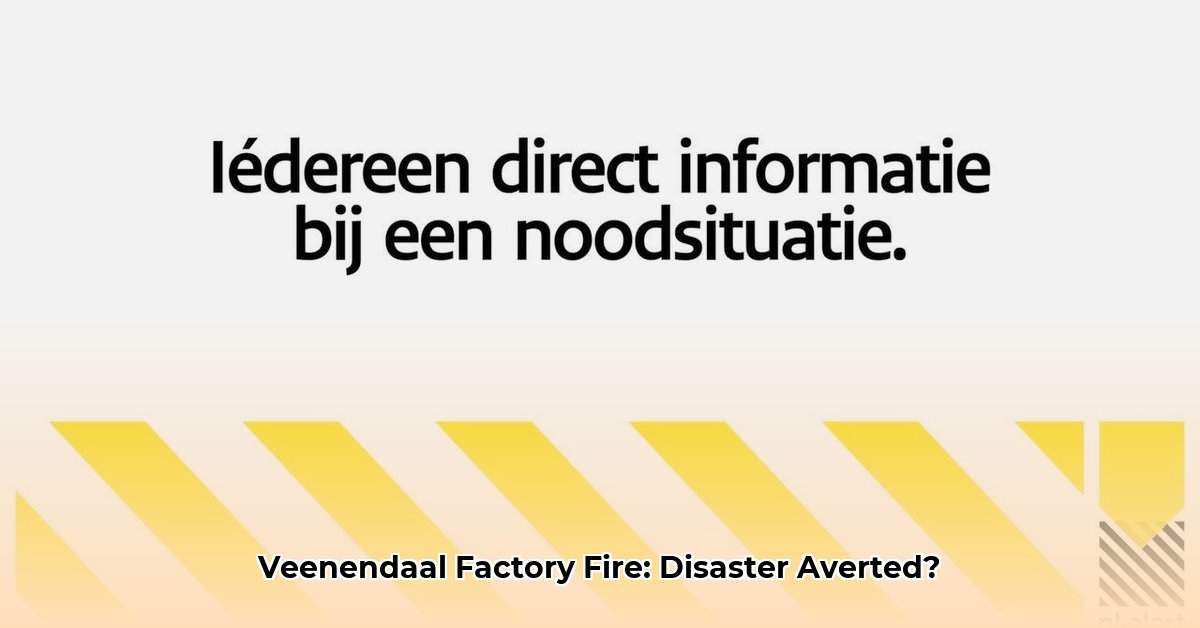
Veenendaal Factory Fire: A Detailed Account
The devastating factory fire in Veenendaal on 2 July 2025 highlighted crucial issues in emergency response and community safety. Two urgent Nl Alert messages were issued, advising residents to close windows and doors due to the significant smoke. This incident serves as a case study for improving emergency preparedness and response in South Africa. The rapid spread of the fire and the resulting impact underscores the need for robust emergency protocols and community awareness programmes.
The Emergency Response: Speed versus Effectiveness
Fire services from across the region responded swiftly, demonstrating the importance of inter-municipal collaboration during major incidents. However, questions remain about the adequacy of the response and whether earlier intervention could have mitigated the damage. Many are questioning how quickly the fire service was able to mobilise. Did the number of vehicles meet the scale of the emergency? This must be examined through an official review.
Unveiling the Cause: An Ongoing Investigation
The exact cause of the fire remains undetermined, pending a thorough investigation. The lack of immediate information, regarding the origin and cause of the fire, has led to public concern, questioning transparency in official communication channels. The investigation needs to be expedited to provide answers to those concerned, and to prevent speculation. Determining the cause is crucial for implementing preventative measures.
Evaluating the Nl Alert System: Reach and Effectiveness
While the Nl Alert messages proved vital in warning residents, concerns persist regarding the system's reach and the clarity of the warnings. Did the alerts reach everyone within the affected zones? Did the messaging effectively convey the urgency of the situation? A post-incident analysis is necessary to assess the effectiveness of the system and identify areas for improvement. Did everyone understand the severity of the situation? The system's efficacy in conveying life-threatening information needs a thorough review.
Lessons Learned and Recommendations: A Path Forward
This incident necessitates comprehensive improvements across multiple areas:
Stakeholder: Short-Term Actions: Long-Term Actions:
Local Government: Review emergency plans, strengthen inter-municipal communication, rigorously test the Nl Alert system. Invest in advanced fire prevention technology; launch comprehensive community awareness campaigns focusing on fire safety and preparedness; modernise building codes, particularly in industrial zones; design and implement improved evacuation routes in high-risk areas.
Fire Departments: Analyze response efficiency, optimise resource allocation and coordination, conduct a thorough post-incident review. Develop advanced fire spread prediction models; invest in specialized training and equipment upgrades; implement innovative evacuation strategies for large-scale incidents.
Residents: Comply meticulously with emergency guidelines; learn emergency procedures; understand the dangers of smoke inhalation. Actively participate in community emergency preparedness programs; review and update home insurance policies; develop and practice family evacuation plans.
Businesses: Assess damage, file insurance claims, upgrade fire safety measures. Develop robust business continuity plans; explore safe relocation options; enhance fire safety systems; consider upgrading buildings to meet higher fire safety standards.
The Veenendaal fire serves as a stark reminder of the importance of fire safety and effective emergency response. The investigation’s outcomes will be crucial in shaping protocols for similar incidents, and the ongoing investigation will undoubtedly shape future safety measures. The swift dissemination of factual information is vital in maintaining public trust and facilitating effective emergency response. Accurate information, even when incomplete, plays a critical role in calming widespread panic and ensuring efficient response strategies.
Enhancing Inter-Municipal Emergency Response Coordination: A National Perspective
The Veenendaal fire underscores the need for improved inter-municipal emergency response coordination across South Africa. Efficient emergency response requires seamless communication and cooperation between different municipalities. The incident demonstrated the interconnectedness of emergency services and the need for preparedness at a provincial level.
Addressing the Challenges: A Collaborative Approach
Many factors hinder consistent and effective emergency responses – including shortfalls in funding, inadequate training, and a lack of standardized procedures. The effectiveness of technology plays a crucial role; reliable systems are key for efficient communication during emergencies. The need for interoperability between systems is paramount to ensuring an efficient response.
Strengthening Inter-Municipal Collaboration: Key Strategies
A multi-faceted approach is needed to improve inter-municipal emergency response coordination:
Improved Communication Systems: Invest in robust, interconnected communication systems to enable instant communication across municipal boundaries.
Standardized Training Programmes: Implement uniform training programmes for first responders to ensure consistent procedures and efficient teamwork.
Joint Emergency Planning: Conduct regular collaborative emergency planning exercises to refine response strategies.
Standardized Protocols: Develop and enforce consistent emergency response protocols across all municipalities, minimizing confusion and maximising efficiency.
Resource Sharing Agreements: Establish agreements to share resources (equipment and personnel), ensuring support during peak demand.
Continuous Evaluation: Regularly review and evaluate emergency responses, using feedback to improve future performance.
This coordinated approach will undoubtedly enhance the effectiveness of emergency responses across the country. Effective communication, integrated planning, and robust resource management are key elements. Such an improved system will minimize response times, reduce the impact of emergencies, and ensure the safety of communities. The implementation of these steps will contribute to a more resilient and prepared South Africa.